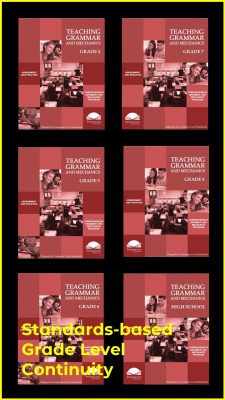Grammar Scope and Sequence
Although the grammar debate* continues between 1. Those who favor part to whole (indirect, implicit, inductive) instruction and 2. Those who prefer whole to part (direct, explicit, deductive) instruction, both sides would generally agree that students should be able to define, identify, and use some things before other things. In other words, the simple academic language and grammatical instruction should precede the more complex. We have solid (and recent–January 2016) educational research to support this instructional sequence of instruction:
*When most teachers refer to grammar we mean the structure of the sentence, the components of the sentence, word choice, the order of words, parts of speech, and usage. Some will also include punctuation, capitalization and even spelling in this terminology. The Common Core authors use the umbrella term language conventions.
Here’s the research to back up these instructional assumptions…
In a January 2016 article, the American Psychological Association published a helpful article titled “Practice for Knowledge Acquisition (Not Drill and Kill)” in which researchers summarize how instructional practice should be ordered: “Deliberate practice involves attention, rehearsal and repetition and leads to new knowledge or skills that can later be developed into more complex knowledge and skills… (Campitelli & Gobet, 2011).”
This is not to say that effective grammatical instruction is not recursive. It is and the writers of the Common Core certainly agree.
The Common Core authors also support a simple to complex instructional scope and sequence in the Anchor Standards for Language…
However, neither the grade-level Standards, nor the Progressive Skills Review, provide a comprehensive grammar scope and sequence. A few examples from the L.1 Standards should suffice to prove these points. Again, notice the simple to complex pattern.
The Conventions of Standard English (Standard 1) requires students to “Demonstrate command of the conventions of standard English grammar and usage when writing or speaking.”
CCSS.ELA-LITERACY.L.1.1.F
Use frequently occurring adjectives.
CCSS.ELA-LITERACY.L.2.1.E
Use adjectives and adverbs, and choose between them depending on what is to be modified.
CCSS.ELA-LITERACY.L.3.1.A
Explain the function of nouns, pronouns, verbs, adjectives, and adverbs in general and their functions in particular sentences.
CCSS.ELA-LITERACY.L.4.1.D
Order adjectives within sentences according to conventional patterns (e.g., a small red bag rather than a red small bag).
Grades 5, 6, and 8 have no specific adjective Standards. Obviously, Grade 5 teachers would review the Grades 1-4 adjective Standards. Common sense is not thrown to the wind by the Common Core authors.
CCSS.ELA-LITERACY.L.7.2.A
Use a comma to separate coordinate adjectives (e.g., It was a fascinating, enjoyable movie but not He wore an old[,] green shirt).
CCSS.ELA-LITERACY.L.9-10.1.B
Use various types of phrases (noun, verb, adjectival, adverbial, participial, prepositional, absolute) and clauses (independent, dependent; noun, relative, adverbial) to convey specific meanings and add variety and interest to writing or presentations.
So, to summarize… Both educational research and the authors of the Common Core State Standards validate a simple to more complex grammar sequence of instruction.
Instructional Implications
- Even a cursory glance at the recent research and the Language Strand and Progressive Skills Review Standards should convince teachers using DOL/DLR (Daily Oral Language / Daily Language Review) and Writers (Writing) Workshop that an order of grammar instruction makes some sense and so re-ordering the instructional sequence of the former openers/bell ringer activities and the mini-lessons of the latter makes sense.
- Selecting a grammar program with a comprehensive instructional scope and sequence, aligned to the Common Core Language Standards, College and Career Readiness Anchor Standards, and/or State Standards makes a lot of sense.
- Defining a specific year-to-year instructional scope and sequence (the Common Core Standards are far too generic) with colleagues provides a game plan and also defines the content for assessment. It makes sense to establish a set of skills and expectations to be mastered at each grade level.
A Model Grammar Instructional Scope and Sequence
Why reinvent the wheel? Download the Diagnostic Grammar and Usage Assessment and the Grades 4-8 Grammar, Usage, and Mechanics Instructional Scope and Sequence tied to the author’s comprehensive grades 4-8 Common Core Anchor Standards for Language programs. Teachers and district personnel are authorized to print and share this helpful planning tool, with proper credit and/or citation. Also check out my articles on Mechanics Scope and Sequence, Spelling Scope and Sequence, and Vocabulary Scope and Sequence.
*****

Pennington Publishing Grammar Programs
Teaching Grammar, Usage, and Mechanics (Grades 4, 5, 6, 7, 8, and High School) are full-year, traditional, grade-level grammar, usage, and mechanics programs with plenty of remedial practice to help students catch up while they keep up with grade-level standards. Twice-per-week, 30-minute, no prep lessons in print or interactive Google slides with a fun secret agent theme. Simple sentence diagrams, mentor texts, video lessons, sentence dictations. Plenty of practice in the writing context. Includes biweekly tests and a final exam.
Grammar, Usage, and Mechanics Interactive Notebook (Grades 4‒8) is a full-year, no prep interactive notebook without all the mess. Twice-per-week, 30-minute, no prep grammar, usage, and mechanics lessons, formatted in Cornell Notes with cartoon response, writing application, 3D graphic organizers (easy cut and paste foldables), and great resource links. No need to create a teacher INB for student make-up work—it’s done for you! Plus, get remedial worksheets, biweekly tests, and a final exam.
Syntax in Reading and Writing is a function-based, sentence level syntax program, designed to build reading comprehension and increase writing sophistication. The 18 parts of speech, phrases, and clauses lessons are each leveled from basic (elementary) to advanced (middle and high school) and feature 5 lesson components (10–15 minutes each): 1. Learn It! 2. Identify It! 3. Explain It! (analysis of challenging sentences) 4. Revise It! (kernel sentences, sentence expansion, syntactic manipulation) 5. Create It! (Short writing application with the syntactic focus in different genre).
Get the Diagnostic Grammar, Usage, and Mechanics Assessments, Matrix, and Final Exam FREE Resource:
![]()
Get the Grammar and Mechanics Grades 4-8 Instructional Scope and Sequence FREE Resource:
![]()
